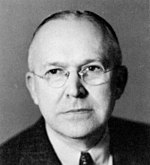Herbert Sinclair Fairbank

Shortly after Francis V. duPont succeeded Thomas H. MacDonald as Commissioner of Public Roads in 1953, he called on Deputy Commissioner for Research Fairbank to describe the Bureau’s research program. Fairbank assembled his Division Chiefs to meet the new Commissioner and to permit each to explain his part in the research effort. Each Division Chief, having grown up in the Bureau during the 34-year tenure of Mr. MacDonald, must have approached this meeting with the new Commissioner with considerable trepidation, and so perhaps did Fairbank. But the tension initially felt in the atmosphere as the meeting convened was soon broken when duPont asked “Mr. Fairbank, does the Bureau engage in fundamental or practical research?” and Fairbank replied, “Oh, practical research—by all means, practical research,” and duPont responded, “That’s good to hear, for there’s no point in doing research if the results can’t be applied.”
In reality the Bureau’s research program went far beyond the usual narrow definition of practical research. Fairbank was constantly looking ahead and exploring how best to meet the needs of the future as he and his associates envisioned them. Yet he constantly demanded that the product of this exploratory work be suitable for practical application. If any program ever faced the need to anticipate and prepare for practical problems resulting from rapidly changing conditions, it was the highway program. And more than anyone else, it was Fairbank whose clear vision and firm hand produced the basic facts needed to guide the policies and determine the programs and methods to keep abreast or ahead of new and changing demands that others did not foresee. While the research was practical, the application of the results was fundamental to the success of the program.
Fairbank’s career spanned virtually the entire development of the modern highway system, from the earliest days of the sand-clay road to the authorization of the Interstate System, and in all stages he took a personal hand. Graduating with a civil engineering degree from Cornell University in 1910, he joined the staff of the then-Office of Public Roads as a student engineer, one of the earliest of the Bureau’s trainees, and was assigned to the Road Improvement Train.
Carrying road construction equipment on flat cars and exhibits and lectures in the coaches, the purpose of the train was to encourage the use of local materials and labor to improve access from farms to the freight stations. The road was conceived as a benefit to the farmer and the railroad alike. So in this period Fairbank became a “lecturer,” and as he said, could deliver his lecture in his sleep as the train stopped at one small town after another through the south and west.
As the next step in his training. Fairbank built object lesson roads to demonstrate rather than just to describe the roadbuilding technique. One assignment was on Martha’s Vineyard, where the technique involved mixing appropriate amounts of sand and clay, a process later achieving wide acceptance in other sections of the country. By virtue of his innate reserve and dignity, Fairbank was not one to whom a nickname would ordinarily be applied, but here he had one. The young engineer and the road he was constructing attracted much interest among a colony of deaf-mutes on the island, who identified him by pointing with a forefinger three times in quick succession, the second and third pointings each being some six inches below the one that preceded. His name in sign language was “3 Buttons,” reflective of a fashionable blue blazer with large pearl buttons he wore when not on duty.
Following his early training and engineering assignments and service as an officer in the Chemical Warfare Service in 1918 and 1919, he was named Editor of Public Roads, the Bureau’s Journal of Highway Research. This was a particularly fitting assignment, for in those days and for many years thereafter, the editor was expected to be not only a competent handler of the language but also an able appraiser of the technical soundness of the reports submitted for publication. Since at
180
